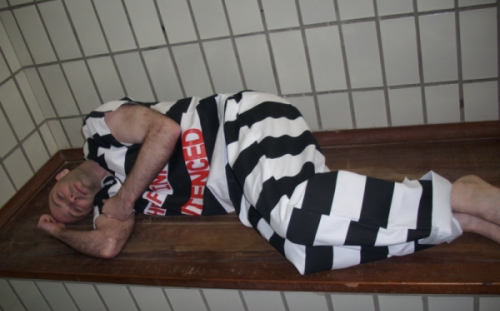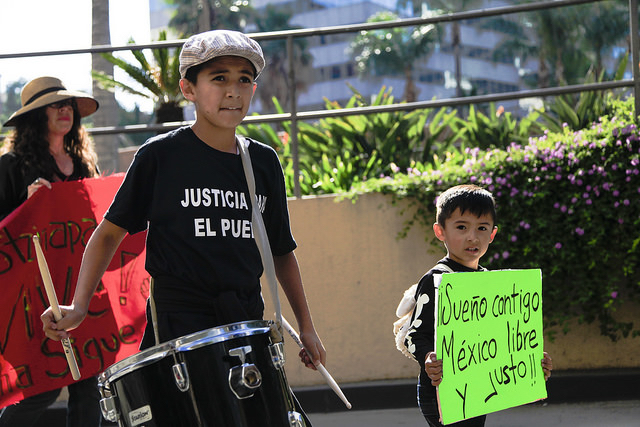Arizona’s extreme right deludes itself that it occupies a central place in American politics. However, there is a difference between being influential, and throwing legislative temper tantrums that gain global notice. Its leading political figures have become internationally scorned, which doesn’t trouble them, and does not harm their electability either. The disjunction between local and external opinion is a matter of local pride, an insularity characteristic of oppressive governments in many areas beyond the American Southwest.
Joe Arpaio, Maricopa County’s sheriff, is the poster boy of Arizona’s penchant for sticking its middle finger up to the rest of the US and the world at-large. Arpaio has been repeatedly elected as sheriff for nearly twenty years, each time with a comfortable majority. He has a rabid local following that delights in his media stunts and defends him endlessly. The continuing stream of lawsuits against Arpaio and current allegations that he misappropriated some $100 million has not dented his popularity. Tough Western-lawman rhetoric is more important than actual deeds.
Arpaio’s reputation can even sell books in Great Britain. The back cover of Shaun Attwood’s 2010 tome Hard Time: A Brit in America’s Toughest Jail advertises that “Before being convicted of money laundering and drug smuggling, he served 26 months in the infamous Arizona jail system run by the notorious Sheriff Joe Arpaio.” The blurb conjures the image of a good-at-heart and rave-loving ‘English Shaun,’ a successful young financier who cocks up with drugs and gets shafted with a saguaro. Arpaio’s name is sprinkled liberally through the book as a sponsoring Satan in this prison hell, although he really has terribly little to do with matters. It’s a system, not its temporary elected deities, that is the crux. An Arizona jail would be the essentially same without Arpaio’s imaginative touches of green bologna and pink underwear.
This is an autobiography of prison time in its intimate details, minus evident interest in interpreting those details or achieving any broader social reflection. It’s rather like reading the incidents of cellblock life in Prison Memoirs of an Anarchist without Alexander Berkman’s capacity for extending his observations into society at-large. Attwood was a bourgeois English adventurer who did foolish business with the locals – a centuries-long story – and remains nearly as unreflective as when he left off diddling accounts for diddling minds. Now out of prison and deported from the US, Attwood has published this first of a projected trilogy and is on tour as a moral reformer telling of his survival in the American badlands.
One invidious feature of prisons in Arizona, California and some other states is the atavistic self-division of prisoners according to race or origin (e.g. Mexicans separate from Chicanos). Prisoners segregate themselves and divide territory under the rule of ‘race heads,’ or senior inmates with lengthy histories of violence. Heads rule with assistance from younger goons and ‘wise men,’ or better-educated counselors. They put ‘contracts’ out on prisoners of their own race-group who ‘disrespect the race’ by associating too freely with other races. Offending prisoners regularly get beaten into the emergency ward for cross-racial fraternizing, owing money, or sex.
In Arizona prisons, anti-racism programming does not exist. Administrative attitudes seem consonant with one court decision stating that it is the duty of prisons to regulate inmate behavior, not their beliefs. Are the two indeed so separable? That position promotes acquiescence to the status quo. On their side of the divide, neither does there appear to be much spirit of quiet resistance among prisoners against such racism. Fear for personal health prevails.
For his part, Attwood simply adapts and gets along with the prevailing apartheid regime. There are other options. In Mother California, Kenneth Hartman – a white lifer – recounts the anti-racist effect of exercising together with a black fellow prisoner: “Our running around the track together every afternoon for years sends a powerful message. This is one of the formative experiences of my life. The two of us would never have spoken to one another or crossed the barrier if we had waited for a peace treaty or an invitation.” The predominance of the Aryan Brotherhood is not an unchangeable situation.
Attwood adapts, beats off phalanxes of cockroaches, avoids unnecessary conflicts, and spends much time pursuing ultimately unsuccessful correspondence to maintain a relationship with his girlfriend. One gets a portrait of Attwood doing yoga, reading the Financial Times, and listening to NPR while looking out on a pod filled with constant brawls and more illicit pharmaceuticals than are available on the street. His English accent gains him some jailhouse leeway. There is an astonishing scene or two, such as a hilarious recounting of an inmate’s public self-installation of a Prince Albert piercing on his prick.
By telescoping incidents occurring over more than two years – a highly unusual length of time to remain in a county jail – Attwood suggests constant daily violence in the Towers jail, which is not the case. But it reads well for a European audience expecting something like an endless Western bar fight behind bars. The book’s title itself is massive hyperbole: Towers jail is far from the toughest jail in Maricopa County, in Arizona, or the US.
Caught up in the Arizona legal system and facing decades in prison, Attwood puts too much faith in a family-financed private attorney’s ability to beat the charges and disparages public defender attorneys (“public pretenders”). He fails to realize that public defenders have plea-bargaining and trial success rates equal to or slightly better than private attorneys, often because they know prosecutor tricks from constant trial practice. Attwood could have gotten the same plea offer for free and saved Dad’s retirement fund. Acquiescing to his fate, he pleads guilty and catches a nine and a half-year sentence. This first volume of the planned trilogy concludes as Attwood leaves Arpaio’s clutches and heads for state prison.
Irrespective of the chemical fascism that established itself as US drug law policy and has filled US prisons to overflowing, it requires a mutuality of idiots like Attwood and ex-DEA agent Arpaio to make such a system work. Attwood sets up a large organization to deal drugs to thousands of people at Scottsdale raves and afterward is surprised that police have been sitting on wiretaps for months to listen to his over-the-phone deals? Arpaio is the smiling wolf a-waiting and Attwood is the sheep – except sheep have better brains.
Attwood says that one reason for writing the book is to inform the US public of jail conditions, create outrage, and bring about change. More delusions. In Arizona, a majority of the public knows well enough and likes it that way. Sheriff Joe offers free tours of local jails and visitors arrive from around the world. A site of human rights abuse has become a tourist attraction. In the end, what Attwood gives us is a self-improvement narrative filled with regrets. He’s a Brit who has become far more American than he realizes.
Photo of Shaun Attwood courtesy of shaunattwood.com





